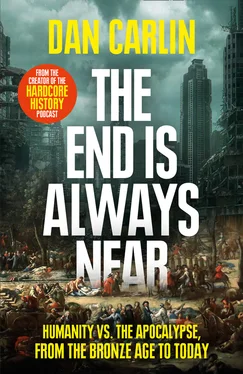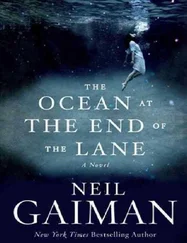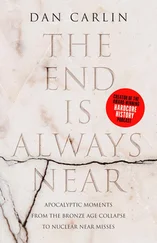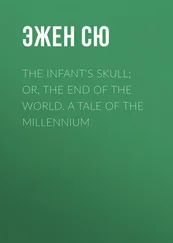The reason waves matter is that one of the theories about how a volcano might be tied to the end of the Bronze Age argues that the tsunamis may have decimated the coastal areas of nearby states. Ships in port would be damaged by a tsunami of any sort, but a megatsunami could also have wreaked havoc on ships in the open sea. A huge wall of water speeding across the ocean might sink anything in its path.[34]
The island of Crete, the heart and soul of the powerful maritime Minoan state, was close to Thera and is often thought to have been a likely victim of the volcano’s explosion.[35] If the ships, facilities, and perhaps settlements and coastal population of Crete were badly damaged or destroyed by the sea, the resulting effect on the economy of the region might have been huge.
It’s also been suggested that widespread damage on a large scale might have weakened the Minoans in a way that made them a tempting target for geopolitical predators in their region. Sometime between about 1450 and 1370 BCE, most of the great palaces from the heyday of the Minoans were destroyed, and eventually the area and culture was taken over by the Mycenaeans.[36] But if the Minoan state declined around 1400 BCE or so, that’s still two or more centuries removed from the other parts of the collapse manifesting. It’s possible that the volcano and the resulting tsunami might have been responsible for this, a chain reaction of events that destabilized what had been a stable system, but that would constitute a long lag time between cause and effect.
The other natural disaster that gets brought into the conversation about the end of the Bronze Age is earthquakes. There’s overlap here, because the Thera eruption may have sparked or been preceded by earthquakes, and these might have contributed to the damage spawned by the volcano. And earthquakes are also one of the primary causes of tsunamis.
There’s no doubt that earthquakes were a relatively regular ancient visitor to this very seismically active region. Damage from earthquakes in ancient times (sometimes including crushed bodies found where they fell) has been discovered in structures all over the eastern Mediterranean and western Asia. In fact, there seem to have been several big earthquakes dated to around the time of the Bronze Age’s end, and lots of important cities in that area show earthquake damage. In the age before stabilized buildings and modern construction, and when open fires were common, the damage done by earthquakes may have been worse than what we’d find today. Certainly, the ability to deal with an earthquake’s aftermath is better in modern times. An earthquake and a resulting tsunami that killed fifty thousand people today would be much easier for us to clean up and recover from than it would have been for a Bronze Age society.
Yet the evidence points often to rebuilding after the historical quakes, which shows that such events weren’t totally fatal and that the affected society could continue. But it doesn’t necessarily mean that population, prosperity, or geopolitical power and influence would return to predisaster levels.
A single phenomenon (such as earthquakes, droughts, volcanoes, or tsunamis) can explain why a particular city or area suffered damage, but it can’t by itself explain why the entire Mediterranean and west Asian region was affected by something at the end of the Bronze Age. Just because there may have been a volcano on an Aegean island that erupted and caused tsunamis, why did Babylon and Assyria, located in landlocked modern-day Iraq, have problems?
Smallpox is one of the most infamous diseases in history. To give an idea of its virulence, it killed an estimated 300 to 500 million people in the twentieth century alone ,[37] but the disease was eradicated from the planet in 1980[38]—meaning half a billion people were killed by smallpox in just eight decades. Those who didn’t succumb to the illness were often left blind, and severely disfigured by scarring. Mercifully, we don’t deal with smallpox anymore, but the illness goes back millennia. When the Egyptian mummy of Pharaoh Ramesses V (r. 1149–1145 BCE) was examined, the body revealed smallpox scarring. (He may have died from the disease.)[39] Smallpox killed multiple reigning European monarchs and five Japanese emperors, and it was likely the cause of many early plagues of history, such as the one in ancient Athens in 430 BCE.[40] Smallpox was also one of the main killers of the Aboriginal peoples of the Americas and Australia after first contact, the majority of whom may have died from the disease before the Europeans who first transmitted it across the oceanic disease barrier actually encountered them.[41]
Just as it is difficult for most of us today to imagine the food insecurity that was common in most human populations in most eras, it’s difficult to conceptualize the range of illnesses and diseases against which earlier cultures had no defense. Pretty much nothing separates us more from human beings in earlier eras than how much less disease affects us. We are still victimized by illness and disease of all kinds, but unlike in the distant past, we now have so many more ways to fight back, and such a better understanding of the underlying reasons for maladies. Real plagues—a common experience in all of human history—are thankfully rare today. Some of our greatest modern fears over disease are simply that we might ever again have one plague as bad as any average plague in earlier eras.[42]
Sources make it sound as though Hattusa (the Hittite capital) was dealing with both famine and plague in this general Bronze Age era.[43] Two successive Hittite rulers succumbed to one plague in around the 1320s BCE. There are reports of plague in the Levant, Cyprus, and Egypt. Several regions in Greece saw depopulation during this era that might have been related to an outbreak of disease.
The Four Horsemen of the Apocalypse often ride together, though, and just as famine and pestilence are interconnected with each other, they are often also linked with war.
Suspect #5: Internecine Warfare
We’ve already discussed violence in different forms leading to the problems in the Bronze Age. From sea peoples to revolutionaries to the Trojan War, there was no shortage of bloody outbreaks as the era came to its close. How is one to make a distinction between the “normal” level of violence and something system threatening? Was there anything about the end of the Bronze Age in a military sense that was different or stood out? Yes, there was: Assyria.
Assyria would become the first of the great empires of the next era, the Iron Age.[44] It was in the later Bronze Age that this Semitic-speaking superpower-to-be began to alter the map of the Near East in ways that could easily upset the region’s geopolitical equilibrium. The Assyrian state, located in modern northern Iraq, and centered on several already ancient cities,[45] had an extensive history and had long been a part of regional power struggles. By about the 1390s BCE, Assyria was about to go on another multigenerational historical winning streak, and much of this would come at the expense of neighboring states in the region.
After falling under the domination of another powerful state in the region (Mittani) in about the 1450s BCE, the Assyrians wrested back their independence after a couple of generations, and then began to take their former overlords apart piece by piece. Leading an increasingly fearsome and effective fighting force, aggressive and energetic Assyrian kings like Ashur-uballit I, Tukulti-Ninurta I, and Tiglath-Pileser I expanded the boundaries of their kingdom and added to its resources.
Assyria’s increasing might eventually began to alarm the other great powers. The Hittites, especially, were right in the crosshairs. The Hittite Empire’s territory formed a key international crossroads in the Bronze Age, a potentially indispensable link in the structure of economic, diplomatic, and military interconnectivity that supported that version of an international system. If something damaged the Hittite state, many others in that system could have felt the effects.
Читать дальше











